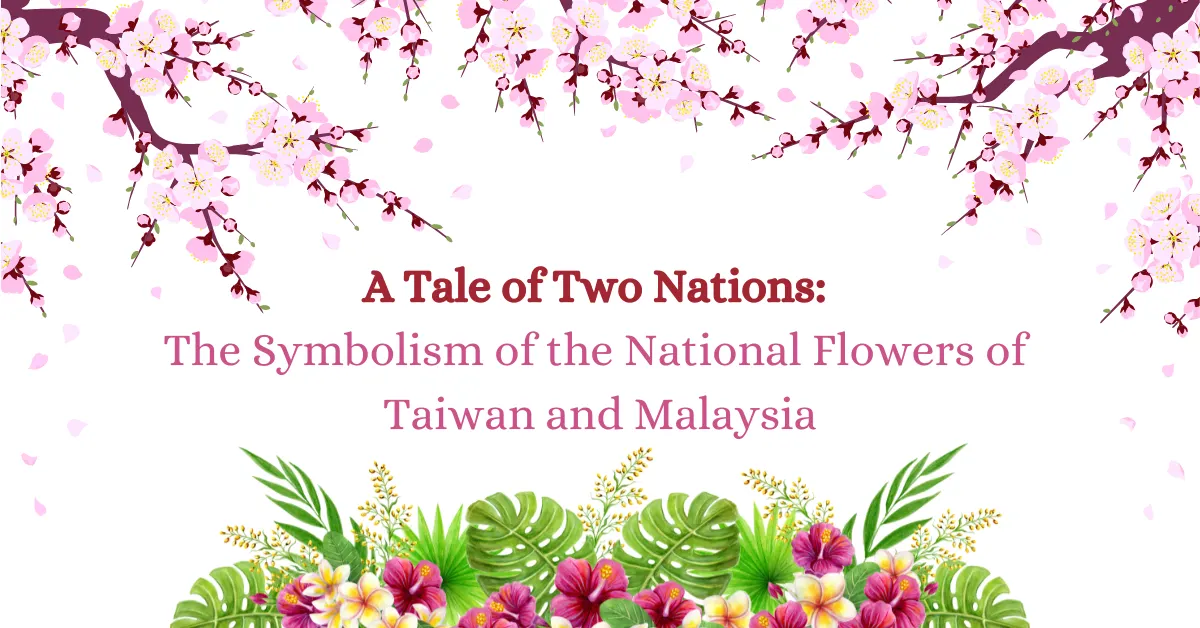A Tale of Two Nations: The Symbolism of the National Flowers of Taiwan and Malaysia
A Tale of Two Nations: The Symbolism of the National Flowers of Taiwan and Malaysia
National symbols often hold deep cultural and historical significance, offering a glimpse into the soul of a country. The national flowers of Taiwan and Malaysia, the plum blossom (méihuā, 梅花) and the hibiscus (bunga raya), respectively, serve as perfect representations of the values and identity of their people. While these flowers bloom in different climates and reflect distinct cultural contexts, both share a common theme of resilience, beauty, and unity.
Plum Blossom of Taiwan: Resilience Amidst Adversity
The plum blossom, officially designated as the national flower of Taiwan (Republic of China) in 1964, is renowned for its ability to bloom vibrantly during the harsh winter. This quality makes it a symbol of endurance, perseverance, and integrity, attributes deeply cherished by the Taiwanese people. The three stamens of the plum blossom represent Dr. Sun Yat-sen’s Three Principles of the People—nationalism, democracy, and the livelihood of the people—while its five petals symbolize the five branches of government under Taiwan's Constitution: the Executive Yuan, Legislative Yuan, Judicial Yuan, Examination Yuan, and Control Yuan.
In traditional Chinese culture, the plum blossom also embodies purity and noble character. It stands as a metaphor for enduring hardship with grace, much like Taiwan itself, which has faced political challenges and external pressures over the years but has thrived as a vibrant and democratic society. The flower’s ability to bloom in extreme conditions is a reflection of the Taiwanese people’s tenacity and strength in overcoming obstacles.
Hibiscus of Malaysia: Unity in Diversity
Malaysia’s national flower, the hibiscus (bunga raya), was officially declared the national symbol in 1960. The striking red petals of the hibiscus represent the courage, life, and rapid growth of the nation. Its five petals symbolize the Rukun Negara, or the Five Principles of Nationhood:
- Kepercayaan Kepada Tuhan (Belief in God)
- Kesetiaan Kepada Raja dan Negara (Loyalty to the King and Country)
- Keluhuran Perlembagaan (Supremacy of the Constitution)
- Kedaulatan Undang-Undang (Rules of Law)
- Kesopanan dan Kesusilaan (Courtesy and Morality)
.
The hibiscus is a tropical flower that thrives in Malaysia's warm and humid climate, symbolizing the country’s ability to flourish in its own unique environment. Malaysia, a multi-ethnic and multi-religious society, mirrors the hibiscus’s vibrant diversity. The flower serves as a reminder of the harmony and unity that is at the heart of Malaysia’s national identity, celebrating the peaceful coexistence of its different cultures, languages, and religions.
Similarities in Symbolism: Resilience, Unity, and National Pride
Though the plum blossom and hibiscus grow in vastly different environments—Taiwan’s cold winters versus Malaysia’s tropical heat—both flowers share the theme of resilience. The plum blossom, thriving in harsh winter conditions, and the hibiscus, blooming vibrantly under the tropical sun, each symbolize their nation’s ability to overcome adversity.
Both flowers also embody the values of unity and national pride. Taiwan’s plum blossom, with its five petals representing the five branches of government, echoes the structure and harmony of the state, while Malaysia’s hibiscus symbolizes the Rukun Negara, the Five Principles that form the foundation of the nation’s unity. In both Taiwan and Malaysia, the flowers are not just beautiful symbols but also reminders of the importance of strength, integrity, and harmony within society.
Differences in Cultural Context: Historical Roots and National Identity
While the plum blossom and hibiscus both convey resilience, their cultural contexts are rooted in different histories. The plum blossom’s significance stems from centuries of Chinese tradition, representing virtues like endurance, purity, and loyalty. It often appears in Chinese poetry, painting, and folklore, symbolizing the noble character of individuals who remain steadfast in the face of trials. This deep historical connection reinforces Taiwan’s identity as a nation with a rich cultural heritage, closely linked to traditional Chinese values.
On the other hand, Malaysia’s hibiscus is more contemporary in its symbolism, chosen to represent the post-colonial, independent identity of a young nation. The hibiscus emphasizes growth, strength, and the harmonious blending of Malaysia’s diverse cultures. While the plum blossom evokes a sense of ancient tradition, the hibiscus reflects Malaysia’s modern, forward-looking identity as a multicultural society united in diversity.
Conclusion: Blooming in Unity
Both Taiwan’s plum blossom and Malaysia’s hibiscus are powerful symbols of national identity and pride. While their differences lie in climate, history, and cultural context, the values they represent—resilience, unity, and perseverance—are shared by both nations. As Taiwan stands tall with the enduring strength of the plum blossom and Malaysia flourishes with the vibrant spirit of the hibiscus, these two flowers offer a reminder of the beauty that comes from enduring hardship and celebrating diversity. In their own way, each flower tells the story of a nation’s journey and the virtues that sustain it through all seasons.



















































